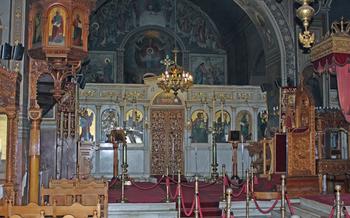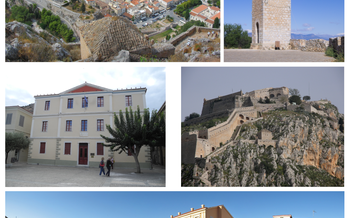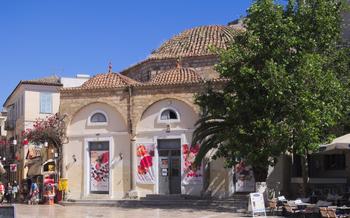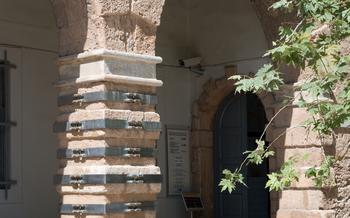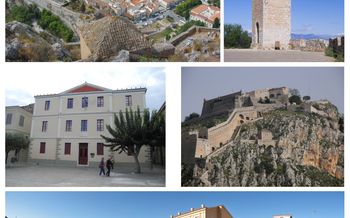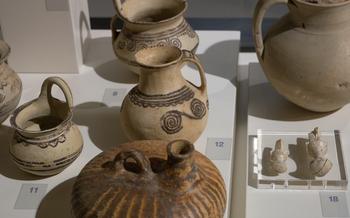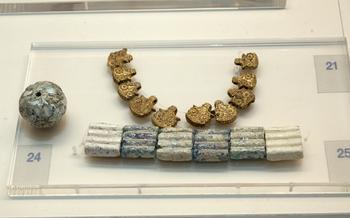
Argos Ancient Theatre
- Historical Significance
- Architectural Marvel
- Performance Venue
- Acoustics and Design
- Seating Arrangements
- Stage and Orchestra
- Restoration and Preservation
- Festivals and Celebrations
- Surrounding Area:
- Ticketing and Accessibility:
- Photo Opportunities:
- Local Cuisine:
- Accommodations:
- Insider Tip: Unveiling the Secret Panorama
Historical Significance
In the heart of the Peloponnese region lies the ancient city of Argos, a place steeped in mythology and history. Here, nestled amidst rolling hills and olive groves, stands the Argos Ancient Theatre, a testament to the grandeur of ancient Greek civilization. Built in the 3rd century BC, this impressive stone structure has witnessed countless dramas, comedies, and musical performances, playing a pivotal role in the cultural and social life of the ancient Greeks.
According to mythology, Argos was founded by Argus Panoptes, a giant with a hundred eyes, who was said to have been placed here by the goddess Hera to watch over her beloved heifer, Io. The city's rich history is intertwined with tales of heroes and gods, battles and conquests, making it a fascinating destination for history buffs and mythology enthusiasts alike.
Architectural Marvel
The Argos Ancient Theatre is a testament to the architectural prowess of the ancient Greeks. Constructed entirely of stone, the theatre boasts an impressive structure that has withstood the test of time. Its unique design and acoustics are a marvel of ancient engineering.
The theatre's seating area is arranged in a semicircle, with 20 tiers of seats rising steeply from the orchestra. The tiers are divided into 12 wedge-shaped sections, called kerkides, by 11 staircases. The lower tiers were reserved for officials and priests, while the upper tiers were for ordinary citizens.
The stage building, or skene, is a rectangular structure that forms the backdrop for performances. It features a central doorway flanked by two smaller doors, as well as a raised platform called the proskenion. The proskenion served as a stage for actors and musicians, and also provided a space for the chorus to perform.
The theatre's acoustics are truly remarkable. Even today, with no modern sound amplification, the spoken word can be heard clearly from every seat in the theatre. This is due to the careful placement of the seats and the shape of the theatre, which creates a natural amplifying effect.
The Argos Ancient Theatre is not just an architectural marvel, but also a living testament to the vibrant cultural life of ancient Greece. Its impressive design and acoustics continue to captivate visitors to this day, offering a glimpse into the rich history and legacy of the ancient world.
Performance Venue
Imagine yourself transported back in time, to an era when the Argos Ancient Theatre was abuzz with life and excitement. Picture the theatre filled to capacity with an eager audience, their eyes fixed on the stage, captivated by the unfolding drama. The air is charged with anticipation as actors donning elaborate costumes take their positions, ready to bring ancient tales to life.
In ancient Greece, the theatre was not merely a place of entertainment but a central part of social and cultural life. It served as a platform for storytelling, education, and communal bonding. Plays often addressed significant social and political issues, sparking lively discussions and debates among the audience.
Today, the Argos Ancient Theatre continues to host a variety of performances, from traditional Greek plays to modern theatrical productions and musical concerts. Attending a performance in this historic venue is an unforgettable experience, allowing you to connect with the past while enjoying the vibrancy of contemporary arts.
Acoustics and Design
The Argos Ancient Theatre boasts exceptional acoustics, a testament to the ingenuity of ancient Greek architects. The theatre's unique design, with its carefully positioned seating and stage, creates an environment where sound is amplified and distributed evenly throughout the space. The theatre's semi-circular shape and sloping rows of seats ensure that every spectator has a clear view of the stage and can hear the performers without distortion.
The theatre's acoustics are based on scientific principles, such as the reflection and absorption of sound waves. The stone construction of the theatre helps to absorb and diffuse sound, preventing echoes and reverberation. The curved shape of the seating rows and the inclined stage reflect sound waves towards the audience, creating a more immersive and intimate experience.
The acoustics of the Argos Ancient Theatre were crucial for the success of ancient performances. Actors and musicians could project their voices and instruments without the need for amplification, ensuring that their words and melodies reached every corner of the theatre. The exceptional acoustics allowed audiences to fully engage with the performances and experience the emotions and messages conveyed by the actors.
Seating Arrangements
In ancient Greek society, the seating arrangements in the theatre reflected the strict social hierarchy. The front rows, closest to the stage, were reserved for the elite and wealthy citizens, including government officials, priests, and honored guests. These seats offered the best views of the performances and symbolized the power and status of their occupants.
The middle sections of the theatre were occupied by the middle class, including merchants, artisans, and free citizens. These seats provided a comfortable and respectable viewing experience, reflecting the growing importance of the middle class in Greek society.
The upper sections of the theatre were designated for the lower classes, including slaves, foreigners, and the poor. These seats were often less comfortable and offered limited views of the stage, emphasizing the social divisions of the time.
As you explore the seating arrangements of the Argos Ancient Theatre, imagine the vibrant atmosphere and social dynamics that unfolded during ancient performances. Visualize the theatre filled with spectators from all walks of life, each experiencing the wonders of Greek drama and communal entertainment.
Stage and Orchestra
The stage and orchestra of the Argos Ancient Theatre played crucial roles in ancient performances. The elevated stage, typically made of wood, served as the primary acting area for actors and performers. It provided a raised platform that enhanced their visibility and allowed them to engage with the audience more effectively.
The orchestra, a circular or semi-circular area in front of the stage, served multiple purposes. It was primarily used by the chorus, a group of singers and dancers who played an integral role in Greek dramas. The chorus provided commentary on the action, expressed emotions, and interacted with the characters on stage. The orchestra also accommodated musicians who accompanied the performances with instruments such as flutes, lyres, and drums, creating a rich and immersive soundscape.
Imagine the stage and orchestra bustling with activity during ancient times. Actors, adorned in elaborate costumes, would deliver powerful monologues and engage in dramatic dialogues. The chorus, with its synchronized movements and harmonious voices, would add depth and emotion to the performances. Musicians would pluck at their instruments, creating melodies that resonated throughout the theatre, enhancing the overall theatrical experience.
Restoration and Preservation
The Argos Ancient Theatre has undergone extensive restoration and preservation efforts over the years to maintain its historical integrity and ensure its longevity. These efforts involve careful archaeological research, meticulous repairs, and the use of traditional techniques and materials to preserve the theatre's original character.
One of the main challenges faced in restoring the theatre is the passage of time and the natural elements that have taken their toll on the ancient structure. Earthquakes, weathering, and erosion have caused damage to the seating areas, stage, and other architectural elements. Restorers must carefully assess the extent of the damage and develop appropriate conservation strategies to preserve the remaining original fabric.
Another challenge lies in balancing the need for restoration with the preservation of the theatre's historical authenticity. While repairs are necessary to ensure the theatre's safety and stability, restorers must also respect the original design and materials used by the ancient builders. This requires a deep understanding of the theatre's construction techniques and a commitment to using traditional materials and methods whenever possible.
The restoration and preservation of the Argos Ancient Theatre are crucial for ensuring that this cultural treasure continues to stand as a testament to the ingenuity and artistry of the ancient Greeks. By preserving this historical site, we not only honor the past but also create a lasting legacy for future generations to appreciate and enjoy.
Festivals and Celebrations
The Argos Ancient Theatre serves as a magnificent backdrop for various festivals and celebrations throughout the year. These events bring the theatre to life, showcasing its cultural significance and vibrant atmosphere. Visitors can immerse themselves in the magic of these celebrations, experiencing the rich traditions and heritage of the region.
One of the most notable events is the annual Argos International Festival, which takes place during the summer months. This festival features a diverse range of performances, including theatre productions, concerts, dance recitals, and art exhibitions. Visitors can enjoy a feast of artistic expression as they witness the talents of local and international performers.
Another popular event is the Ancient Drama Festival, which celebrates the rich history of Greek theatre. During this festival, classic Greek plays are performed on the ancient stage, transporting audiences back in time to the era of Sophocles, Euripides, and Aeschylus. These performances offer a unique opportunity to experience the power and emotion of ancient Greek drama in its original setting.
These festivals and celebrations not only provide entertainment but also serve as a bridge between the past and the present. They honor the legacy of ancient Greek culture while showcasing the vibrant artistic scene of modern Greece. Visitors can immerse themselves in the local culture, engage with the community, and create lasting memories amidst the grandeur of the Argos Ancient Theatre.
Surrounding Area:
The Argos Ancient Theatre stands as a testament to the region's rich history and cultural heritage. Beyond the theatre, Argos offers a wealth of other historical sites and attractions waiting to be explored. Take a leisurely stroll through the charming Old Town, where narrow cobbled streets lead you past traditional Greek houses, Byzantine churches, and quaint shops. Visit the Archaeological Museum of Argos to delve deeper into the region's past, showcasing artifacts from prehistoric times to the Roman era. Don't miss the nearby Heraion of Argos, a sanctuary dedicated to the goddess Hera, featuring impressive ruins and stunning views of the surrounding countryside. For those seeking a unique experience, venture to the Mycenaean Acropolis of Tiryns, a UNESCO World Heritage Site, where you can explore the remains of a Bronze Age palace and marvel at the cyclopean walls that still stand today. With so much to see and do, Argos promises an unforgettable journey through the annals of time.
Ticketing and Accessibility:
Visiting the Argos Ancient Theatre is a breeze with its convenient ticketing system. Tickets can be purchased online or at the theatre's box office. Prices vary depending on the type of performance or event, but generally range from 10 to 20 euros. Discounts are available for students, seniors, and groups.
The theatre is fully accessible for visitors with disabilities. Wheelchair ramps and designated seating areas ensure that everyone can enjoy a comfortable and inclusive experience. Additionally, audio guides and sign language interpreters are available upon request to enhance the accessibility of performances for visitors with hearing or visual impairments.
To make the most of your visit, plan your trip in advance by checking the theatre's website for upcoming events and performance schedules. Arrive early to avoid queues and take your time exploring the theatre's surroundings, including the nearby Archaeological Museum of Argos. Remember to bring comfortable shoes as you'll be doing a fair amount of walking on uneven surfaces.
Photo Opportunities:
The Argos Ancient Theatre offers a wealth of photo opportunities for enthusiasts and casual photographers alike. With its stunning architecture, picturesque surroundings, and vibrant atmosphere, the theatre provides a captivating backdrop for capturing memorable shots.
Stand at the center of the theatre and take in the panoramic view of the stone tiers rising towards the sky. Capture the intricate carvings and sculptures that adorn the structure, adding depth and character to your photos. Experiment with different angles to create dynamic compositions that showcase the theatre's grandeur.
As the sun casts golden hues across the theatre, seize the chance to capture the magic of the moment. The warm light illuminates the ancient stones, creating a breathtaking spectacle that will transport viewers back in time. Don't miss the opportunity to capture the theatre's beauty under the starry night sky, when the theatre takes on a mystical aura.
Encourage your readers to share their stunning shots of the Argos Ancient Theatre on social media, using relevant hashtags to connect with fellow travelers and photography enthusiasts. Inspire them to share their unique perspectives and experiences, creating a visual tapestry of this remarkable historical site.
Local Cuisine:
Indulge in the culinary delights of Argos, where traditional Greek cuisine tantalizes the taste buds. Savor the flavors of freshly caught seafood, succulent grilled meats, and crisp salads bursting with local produce. For an authentic experience, venture into the charming tavernas and ouzerias that line the narrow streets. Don't miss the opportunity to try regional specialties like "kleftiko" (slow-cooked lamb) or "stifado" (beef stew with onions and red wine). Pair your meal with a glass of local wine or ouzo, and soak in the vibrant atmosphere as you enjoy the flavors of Greece.
Accommodations:
To fully immerse yourself in the charm of Argos, consider staying in one of the many hotels or guesthouses in the vicinity of the ancient theatre. The Hotel Leto, located just a stone's throw from the theatre, offers stunning views of the surrounding landscape and easy access to all the historical sites. For a more budget-friendly option, the Nafplia Youth Hostel provides comfortable accommodation and a social atmosphere. Alternatively, for a truly unique experience, book a room at the Palamidi Castle Hotel, situated atop the historic Palamidi Fortress, which offers breathtaking panoramic views of the city and the sea. No matter your preference or budget, you'll find a range of accommodation options to suit your needs, ensuring a comfortable and memorable stay in Argos.
Insider Tip: Unveiling the Secret Panorama
Venture beyond the theatre's grand facade and discover a hidden gem known only to locals. A short walk uphill from the ancient site leads to a secluded spot offering a breathtaking panorama of Argos and the surrounding countryside. Here, you can escape the crowds and soak in the beauty of the region in tranquil solitude. As the sun dips below the horizon, the sky transforms into a canvas of vibrant colors, creating a magical backdrop for your unforgettable experience.
